Alarm gong systems deliver warning that sprinklers are operating—even without a power supply
Essentially, water motor gongs are fire alarm bells that don’t need electricity to operate. Instead, they’re physically triggered by water flowing through a fire protection system—making it easy to meet fire code requirements to sound a continuous alarm, even if electrical power is lost.
In this blog, QRFS explains how water motor gongs work. We discuss when they are required by fire codes, and the distinct advantages they offer when connected to fire protection systems.
Need a water motor gong for your fire sprinkler or standpipe system? Check out our UL-listed, FM-approved Viking Model F-2 Water Motor Gong.
When do fire codes require water motor gongs?
A ringing outdoor bell makes it abundantly clear that water has started to flow through a fire sprinkler or standpipe system. It warns people to steer clear of the building and contact the fire department if necessary.
When these bells are strategically placed, they are also useful for guiding firefighters to the fire department connections (FDCs) that help supply water to the building’s fire protection systems.
Fire alarm bells are connected to fire risers, or pipes outfitted with essential system components that serve as the hub of a fire protection system. During a fire, water passes through the system riser from an outside source such as a water tank or municipal supply line. It then flows to a series of other pipes leading to fire sprinkler heads, permanently mounted hoses, or hose connections.
Since the riser is at a fire protection system’s point of origin, it marks the ideal location to install devices designed to detect changes in flow or pressure throughout the entire system.
The 2019 edition of NFPA 13: Standard for the Installation of Sprinkler Systems (16.11.2.1) requires local waterflow alarms on every sprinkler system with more than 20 sprinklers. When alarms are “local,” they are not connected to emergency response—requiring those who hear them to call the fire department if necessary.
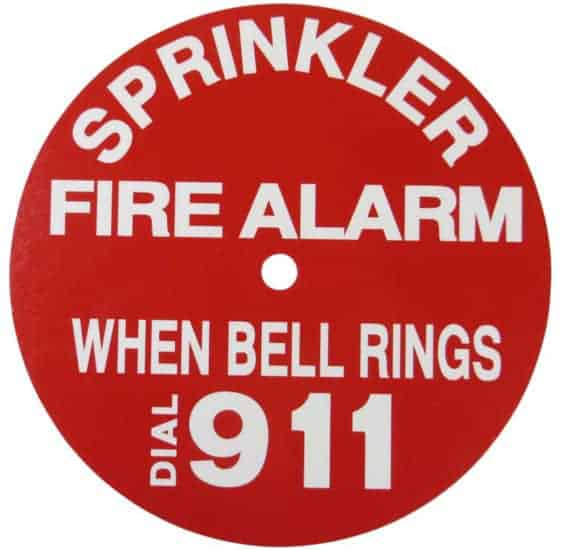
Fire codes allow contractors to install water motor gongs or electric fire alarm bells as part of local waterflow alarms in fire protection systems. That includes standpipes as well as sprinkler systems.
In Section 16.11.1, NFPA indicates that a local waterflow alarm must have either:
- A listed mechanical alarm, horn, or siren
- A listed electric gong, bell, speaker, horn, or siren
To learn about the differences between mechanical water motor gongs and electric sounders like outdoor-rated fire alarm bells, read our previous blog, “How Fire Bells and Water Motor Gongs Work with Fire Risers.”
The International Code Council’s (ICC) model building (IBC) and fire (IFC) codes specifically require exterior alarms connected to fire protection systems.
From the 2018 edition of IBC
903.4.2 Alarms. An approved audible device, located on the exterior of the building in an approved location, shall be connected to each automatic sprinkler system. Such sprinkler waterflow alarm devices shall be activated by water flow equivalent to the flow of a single sprinkler of the smallest orifice size installed in the system. Where a fire alarm system is installed, actuation of the automatic sprinkler system shall actuate the building fire alarm system.
NFPA 13 allows—but doesn’t specifically require—fire protection systems to connect to exterior alarms. But section A.16.11.1.1 notes that these audible alarms “are normally located on the outside of the building.” It qualifies, however, that outdoor alarm bells may not be needed if the sprinkler system is part of a monitored fire alarm system that uses “listed audible inside alarm devices.”
Even so, it is NFPA 13 that offers guidance for arranging equipment to provide an audible outdoor signal. The standard also establishes the requirement that the audible signal must operate as long as the water is flowing.
From the 2019 edition of NFPA 13
7.7 Waterflow Alarm Devices. Waterflow alarm devices shall be listed for the service and so constructed and installed that any flow of water from a sprinkler system equal to or greater than that from a single automatic sprinkler of the smallest K-factor installed on the system will result in an audible alarm on the premises within 5 minutes after such flow begins and until such flow stops.
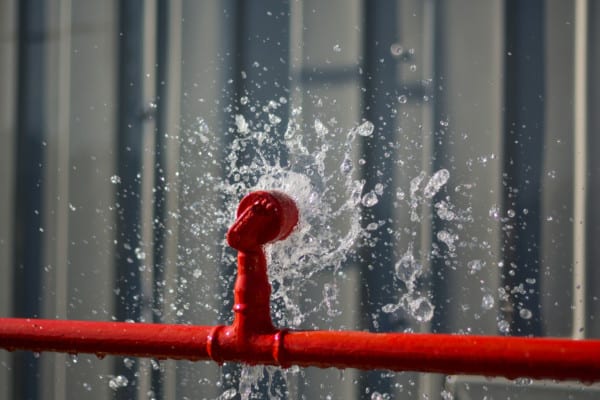
Here’s how water motor alarms work
A water motor gong is a large, wall-mounted bell covered with a protective guard that’s often installed on the outside wall of a fire riser room.
These alarms can be used in conjunction with alarm check, dry pipe, deluge, and preaction valves. Wet sprinkler systems need alarm check valves to utilize water motor gongs, but other sprinkler systems can be configured to work with their existing valves.
Overall, an alarm check valve works the same as any other check valve, making sure:
- Water only flows in one direction—in this case, toward the sprinklers or hose connections that need it.
- System pressure is maintained.
But alarm check valves also feature an alarm port that feeds water toward the outdoor alarm bell. When a sprinkler head opens, the water’s force pushes the flapper valve covering the alarm port out of the way. As long as the sprinkler system flows water, the water motor gong will operate.
In many cases, a container called a retard chamber stands between the alarm port and the water motor alarm. Retard chambers can be added to an alarm line to help reduce the nuisance of false waterflow alarms caused by variable pressure or water surges in a system.
A retard chamber absorbs and drains water surges through a restricted orifice at the bottom, preventing normal fluctuations from triggering false alarms. During a sprinkler flow condition, the chamber fills more quickly than it is drained, causing the water to overflow into adjacent pipes and fittings.
This overflow activates the water motor alarm, creating an audible signal that there is water flowing in the fire protection system. Watch this video to see a water motor alarm activate during testing:
Here’s a step-by-step explanation of how a specific top-rated water motor gong—the Viking Model F-2 Water Motor Gong—works:
- When a sprinkler system is activated, water flows through a check or other valve, pushing its clapper open.
- The water flows from the valve’s alarm port, through a strainer and alarm line piping, into the inlet of the water motor.
- From the inlet orifice, the water flows through a nozzle (labeled “4” on the illustration below) that restricts the flow into a pressurized stream directed onto the impeller (7).
- The force from the water stream turns the impeller and driveshaft (10), causing the striker arm (20) to rotate.
- The striker (25) impacts against the gong (16), producing a continuous 90-decibel alarm. A minimum of 5 PSI (.34 bar) is required at the nozzle to cause a continuous alarm. (PSI represents pound-force per square inch.)
- After passing through the water motor gong, the water is discharged through a 1″ (25 mm) drain outlet at the bottom of the impeller housing. The discharged water must be piped through the wall into the atmosphere or a suitable open drain.
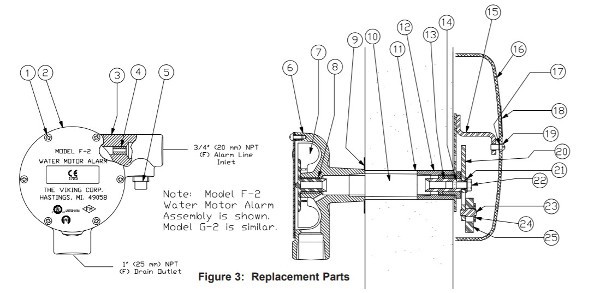
When do water motor gongs offer an advantage?
Since water motor gongs don’t need electricity, contractors may prefer them over electric fire alarm bells in situations where wiring isn’t accessible or easy to install. They also can provide an advantage in cases where power outages or poor wiring make electricity unreliable.
Lightning can wreak havoc on electrical systems, including fire alarms. In some weather-prone areas, installers may choose water motor gongs to create a mechanical fail-safe for fire protection systems.
Water motor gongs can also help fire departments quickly identify a lack of pressure in fire sprinkler systems. If the gong is ringing slowly when firefighters arrive, firefighters may deduce that a larger fire may have caused several sprinkler heads to open and the system is not receiving enough pressure.
If the water motor gong speeds up after the fire department’s pumper truck attaches to the building’s FDC, firefighters will know they are boosting the system’s ability to fight the fire with higher water and pressure. While they have certain benefits, electric fire alarm bells can’t provide the same feedback during an emergency.
Water motor gongs also avoid some types of false alarms. Where a sudden surge in pressure or an air compressor failure might trigger an electric bell, a water motor gong will ring only for a moment as the pressure changes, and then stop.
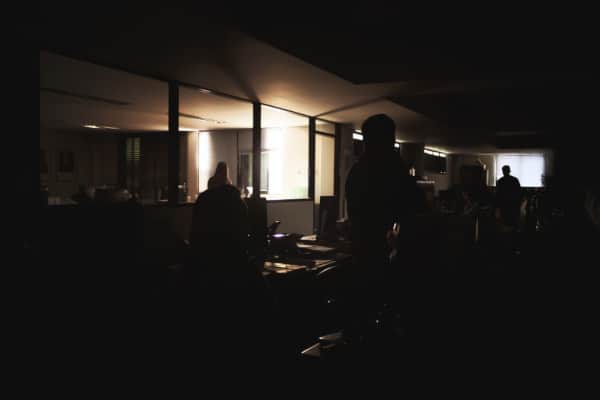
Special considerations for using water motor gongs
- NFPA 13 (16.11.8) doesn’t recommend water motor gongs if more than 75’ of piping is required to join the alarm to the fire protection system valve. Not only can it be impractical and expensive to run pipes in buildings where riser rooms are located far from exterior walls, but it can also fall on the wrong side of code compliance.
- NFPA 13 (16.11.8) also doesn’t recommend placing water motor gongs 20’ or more above the valve or alarm device.
- NFPA 13 (11.1.3) states that piping to water motor-operated devices can only be galvanized steel, brass, copper, or other approved metallic corrosion-resistant material of not less than ¾” (20 mm) nominal pipe size.
- Electric and mechanical fire alarm bells may be used with preaction and deluge systems. However, while water motor gongs meet NFPA 13 (16.11.3.3) requirements for these systems to maintain alarms actuated “by the flow of water,” they don’t meet the section’s mandate for alarms actuated “by the detection system.” Preaction and deluge systems will still need a separate notification device.
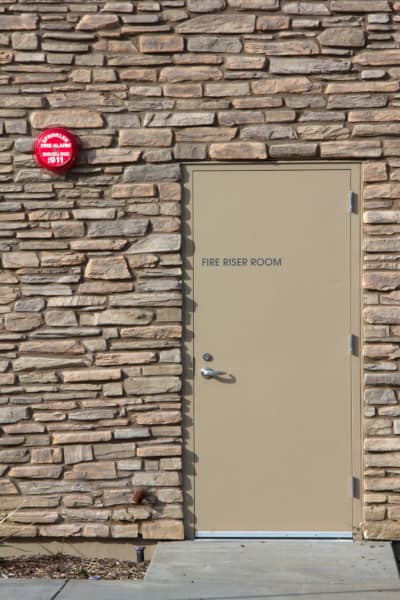
Tips for maintaining water motor gongs
Since they are used outdoors, weather-resistant materials are employed in the construction of water motor alarms. For instance, the Viking Model F-2 Water Motor Gong is made of corrosion-resistant aluminum and steel.
Even so, it’s wise to examine and test these devices at regular intervals to ensure that the nozzle and drain line are clean and free of obstruction and that the alarm functions properly.
You should also regularly clean and inspect the alarm line strainer located at the alarm outlet of the waterflow detecting device, or the outlet of the retard chamber, if used. Some retard chambers may be equipped with a built-in strainer.
The 2020 edition of NFPA 25: Standard for the Inspection, Testing and Maintenance of Water-Based Fire Protection Systems offers detailed guidance for maintaining water motor gongs. Your local authority having jurisdiction (AHJ) may also have additional ITM requirements.
Be sure to notify the AHJ—as well as people in the area covered by the fire protection system—before attempting ITM that will temporarily disable a water motor alarm.
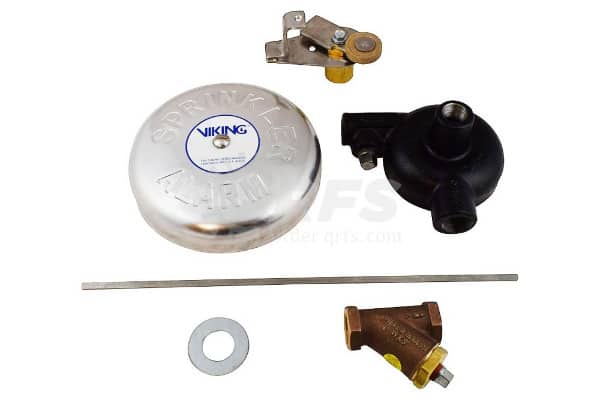
Water motor alarms provide crucial information in an emergency
As hydraulically operated mechanical devices, water motor gongs will sound an alarm for as long as fire protection systems activate—even without power. Understanding how they work offers insight into the advantages they provide for keeping people and property safe during emergency events.
Need a water motor gong for your fire sprinkler or standpipe system? Check out our UL-listed, FM-approved Viking Model F-2 Water Motor Gong, which includes an aluminum gong and a steel cover, along with a complete motor and striker assembly.
This blog was originally posted at blog.qrfs.com. Check us out at Facebook.com/QuickResponseFireSupply or on Twitter @QuickResponseFS.


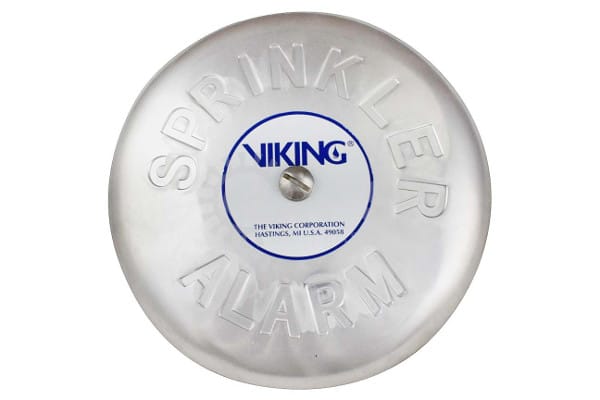
Need a price for a replacement of water gong for fire sprinkler system
Thank you
Thank you for reaching out. We will have someone from our QRFS Customer Support Team contact you, and you can also email any requests there to get faster service!
Is there a specific audibility requirement or decibel level for water motor gongs?
Some of the older ones we have found spin freely but are a bit quite.
Forrest — In terms of NFPA standards, NFPA 72 that specifically deals with alarms has various audibility specs, but NFPA 13 for sprinkler systems does not get into the decibel levels of water motor gongs. Instead, it specifies (NFPA 13, 2022: 16.11.1.1*) they must be “listed” for their fire protection system use (we have not reviewed the specifics of motor gong listings, but audibility is likely among them). Thanks for reading.
Do you know of any way to connect two retard chambers to a single water gong?
Note that both systems work in the same building – one section was built in 1930 and the other in 1970.
Is this allowed?
While overhauling a system we are finding new problems with check valves on the outputs not allowing the retard chambers to empty.
The prior check valves were so corroded that they let air into the chambers, but the system had many many design issues so the system was not working correctly, and this only contributed to the problem.
Whyrl — We can’t really assess the situation properly and provide feedback in this format. Your best bet is to contact another pro (likely a system designer, it sounds like) to assess the specific scenario in detail. Best of luck and thanks for reading.
Why, when my lawn sprinklers shut off does my fire sprinkler alarm sound momentarily? This is a recent occurrence after my plumber replaced the main water shutoff valve.
Stan — We cannot speculate about why lawn sprinklers shutting off would impact your fire sprinkler alarm, which would sound when water flows. You should contact a local fire sprinkler professional.
For a building with multiple floors (more than one alarm check/FCA); to what alarm check would you connect the waterflow gong?
Shawn – most multi-floor buildings tend to use electrical flow switches connected to alarms (vs. mechanical switches/gongs), but each separate system needs a flow switch, so if using a mechanical alarm, each floor would need one. It also may be possible to ‘gang’ multiple alarm valves to a common single water motor gong. In any event, you should consult an installation and/or design pro to asses your specific situation and provide an authoritative answer. Thanks for reading!